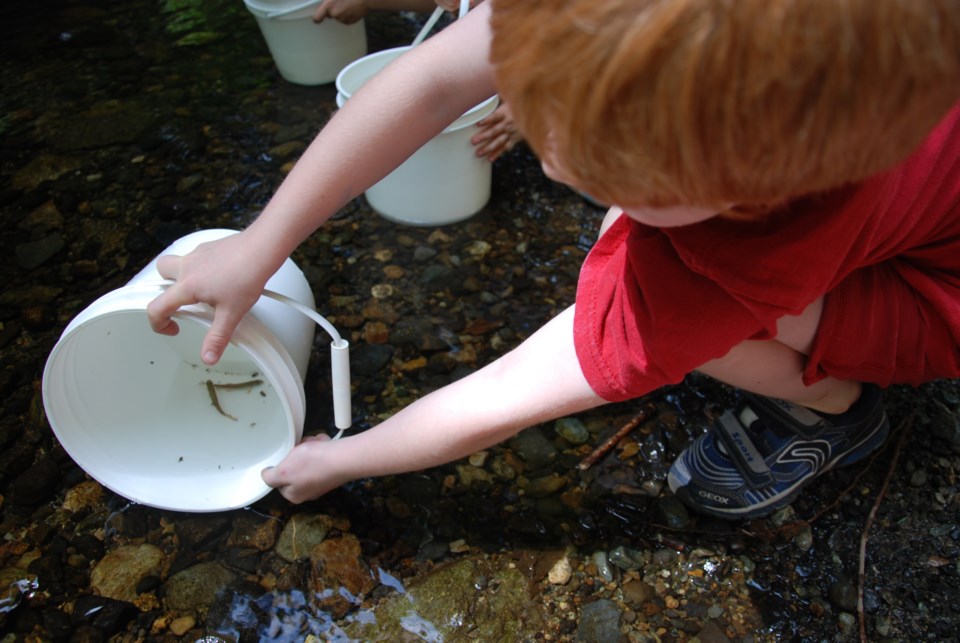LOUISE LOIK
EDITOR
Bucket by bucket, children carried coho salmon spawn from
the Bowen Island fish hatchery to Terminal Creek last Sunday,
releasing little salmon for their first experience with life outside a
tank.
In the hopes that Bowen will have some wild salmon return
to these shores over the next couple years, the hatchery releases
three types of salmon fry in a variety of creeks over the course of
the year every year. Every year in June, hundreds of locals turn up
in Crippen Park to learn about salmon, their habitat, and to help
release the thousands of coho fry into the creek adjacent to the
fish hatchery. This year approximately 400 people turned up to
help the Bowen Island Fish and Wildlife Club release the 12,000
fry.
Tim Pardee, a volunteer with the club, enjoys seeing the children
at the hatchery.
“The little ones see the salmon for the first time, and their eyes
light up,” says Pardee,.
“There was a time, 10-15 years ago, when the creek up here
was red with salmon. That doesn’t happen anymore and we don’t
know why,” he adds.
A decade ago, large powerful coho salmon would dodge past
a gauntlet of seals guarding access to the Terminal Creek pond.
The fish, after avoiding predators for two years of life in the open
ocean, would come back to where their lives began. The fish
would line up, nosing the causeway ramp, side by side at a high
tide. They waited for just the right rush of water to release a burst
of energy that might be enough to propel them up the ramp and
into the pond. Sometimes they made it, and sometimes the fish
would have to try again and again.
Crowds used to gather along the causeway, watching the spectacle
of the return of the salmon. Some salmon spawned in the
pond, but the coho were compelled to tackle the waterfalls before
spawning. At the falls, fish would do leaps of two metres or more,
and even then, some would not clear the falls. Instead, they
bounced off a rock at the top of their leap and slid back to the
bottom to rest and try again.
The club typically releases 100,000 each of pink and chum
salmon annually to creeks around the island, including Davies,
Terminal, Grafton and Killarney. These salmon arrive at the
hatchery as eggs in the fall, and are ready for release in the spring,
prior to the coho. While the coho need to spend one year in
streams and creeks before heading to sea, the pink and chum
must get to salt water as soon as they are four or five inches long.
When the pink are released, they stay in the fresh water for only
a day or two, while the spring will stay in the fresh water after
Coho salmon
send-off a success
continued PAGE 10
then they need the salt water.
The coho may be in the same
creek as the chum and pink,
but they stay hidden as much
as possible during their long
wait to swim in the sea. Much
of the time they will hide
under logs.
Pardee says coho are in distress
up and down the West
Coast, adding that he hasn’t
seen any returning coho.
Pardee says that someone
noticed salmon fry in a Deep
Bay Creek. When he went to
check out the fish, he discovered
that they were coho fry,
approximately 100 of them,
unexpectedly in a creek that
would be dry within a month
as summer rolled in. “We
rescued the salmon, brought
them to the hatchery and fed
them and after a week, released
them into Terminal Creek.”
This sort of vigilance and
effort is nothing unusual for
the members of the club.
According to Metro Parks,
in the past year, volunteers
with Bowen Island Fish and
Wildlife gave 1,000 hours of
service to salmon projects and
public engagement.
For Pardee, the time is
well-spent. “It’s all to support
wild salmon,” he says. “All
the habitat work we do is for
the salmon. It’s all very worthwhile.”
We’re giving wild salmon a
fighting chance.



